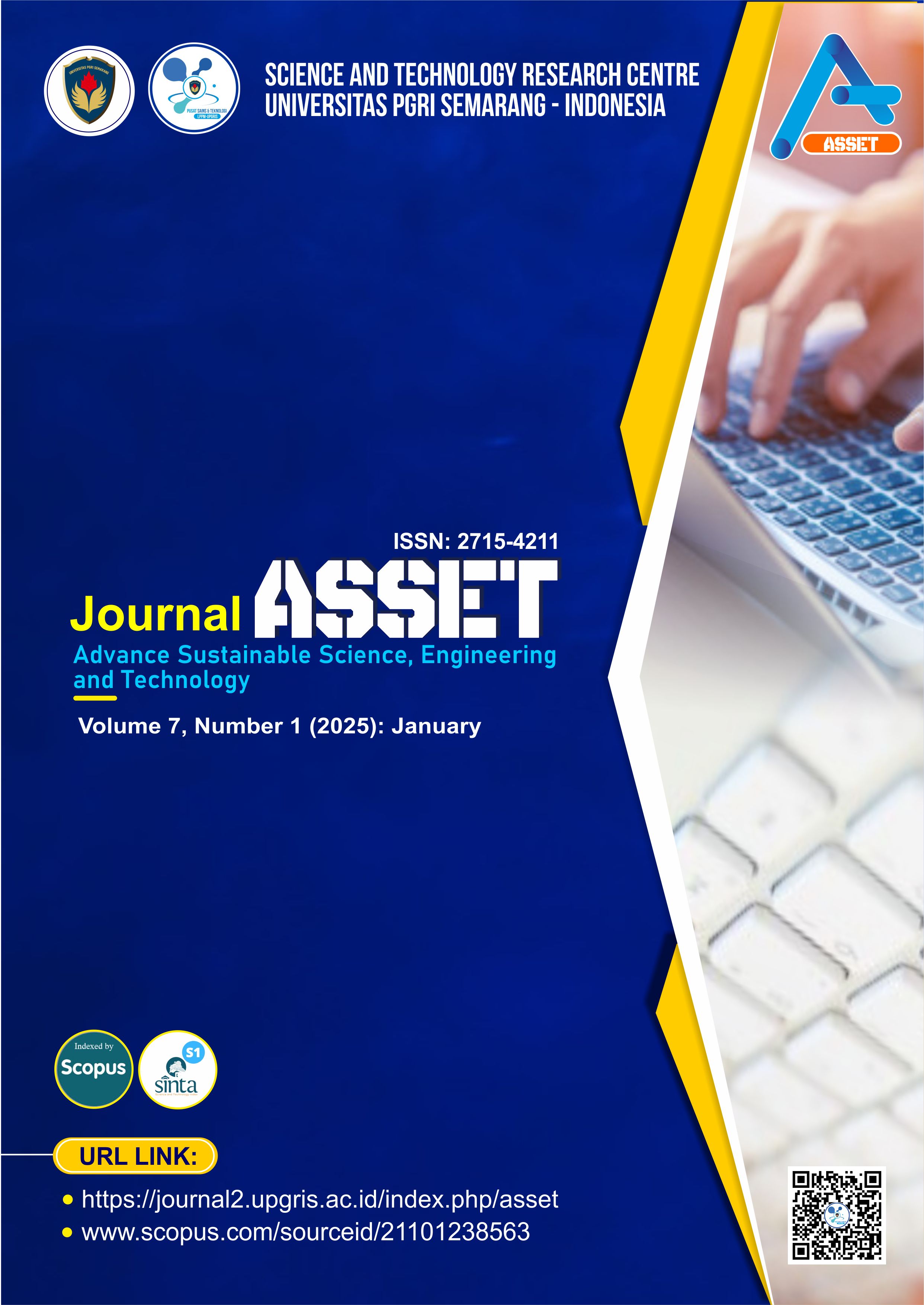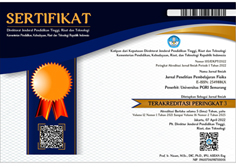Improving Road and Sidewalk Accessibility for Persons with Disabilities: Infrastructure Challenges and Legal Compliance in Indonesia
DOI:
https://doi.org/10.26877/asset.v7i1.1465Keywords:
Urban Accessibility, Disability Infrastructure, Universal Design, Disability Rights, IndonesiaAbstract
Research to address significant challenges related to public infrastructure accessibility, especially for disabilities, regarding regulations that govern accessibility, the implementation in the field is still far from adequate. The research aims to evaluate the condition of public infrastructure, identify accessibility barriers for disabilities, and provide recommendations for future improvements. A mixed-methods approach, with participatory research methodology, provides significant contributions to disability and urban planning. Probability sampling method, with 150 respondents, physical, intellectual, and sensory disabilities, as well as experiences and challenges of accessibility. Data analysis, qualitative and quantitative methods, thematic analysis to analyze qualitative data about PWD experiences, descriptive and inferential statistical analysis for quantitative data. The findings indicate that road and sidewalk infrastructure is inadequate, with uneven surfaces, a lack of supporting facilities such as ramps, and unclear signage. Persons with disabilities are isolated from participating in public spaces, highlighting the gap between regulations and their implementation on the ground. The findings emphasize the integration of universal design in future infrastructure planning. Involving disabilities in planning results in more inclusive and effective solutions. Improving training and awareness for urban planners, along with regular monitoring of public infrastructure, ensures compliance with accessibility standards, moving towards a Smart Disability City (SDC)
References
[1] V. S. Pineda, “What Is Inclusive and Accessible Public Space?,” The Journal of Public Space, vol. 7, no. 2, pp. 5–8, 2022, doi: 10.32891/jps.v7i2.1607.
[2] Ç. Erçin, “Analysing the Design Criteria of Public Open Spaces for the Disabled Persons: An Evaluation of Kumsal Park in Northern Cyprus,” European Journal of Sustainable Development, vol. 12, no. 3, p. 277, 2023, doi: 10.14207/ejsd.2023.v12n3p277.
[3] A. S. Amin, M. A. A. Razak, and N. M. Akhir, “Access to Transportation: The Experiences of Women With Physical Disabilities,” International Journal of Academic Research in Business and Social Sciences, vol. 11, no. 6, 2021, doi: 10.6007/ijarbss/v11-i6/10219.
[4] B. A. Whaley, “The Americans With Disabilities Act and Equal Access to Public Spaces,” Laws, vol. 13, no. 1, p. 5, 2024, doi: 10.3390/laws13010005.
[5] D. Fernando, H. Galpaya, G. Hurulle, and C. Mobley, “Disability and Place of Living: Experiences of Disability, Accessibility, and Inequality in Four Regions of Myanmar,” Scandinavian Journal of Disability Research, vol. 25, no. 1, pp. 170–182, 2023, doi: 10.16993/sjdr.954.
[6] S. Mozūriūnaitė and J. Sabaitytė, “To what extent we do understand smart cities and characteristics influencing city smartness,” Journal of Architecture and Urbanism, vol. 45, no. 1, pp. 1–8, 2021, doi: 10.3846/jau.2021.12392.
[7] H. Sakawati, A. C. Susilawati, and S. Sulmiah, “Accessibility of Public Services for Persons With Disabilities at the Makassar City Social Service,” Jurnal Ad Ministrare, vol. 9, no. 2, p. 485, 2022, doi: 10.26858/ja.v9i2.38971.
[8] M. R. d. Rosa and E. N. Pereira, “Design and Development of a Collaborative App With Accessibility Information About Tourist Sites,” Interfaces Científicas - Humanas E Sociais, vol. 9, no. 2, pp. 496–511, 2021, doi: 10.17564/2316-3801.2021v9n2p496-511.
[9] A. Watharow and S. Wayland, “Making Qualitative Research Inclusive: Methodological Insights in Disability Research,” Int J Qual Methods, vol. 21, 2022, doi: 10.1177/16094069221095316.
[10] D. Rakhmawati and F. M. Dewanto, “Development of Counseling Sites with Digital Accessibility Features for the Blind and Visually Impaired Students,” vol. 7, no. 1, pp. 1–11, 2025.
[11] N. Sisinyize, “Enhancing Access to Learning Aids and Resources at Windhoek Correctional Facility,” J. Edu. For. Sustainable Inno, vol. 1, no. 2, pp. 106–112, 2023, doi: 10.56916/jesi.v1i2.571.
[12] W. Maulana Prawiro and E. Rosi Subhiyakto, “User-Centered Design Approaches to Enhance Employee Attendance Applications,” Advance Sustainable Science Engineering and Technology, vol. 6, no. 3, p. 02403025, 2024, doi: 10.26877/asset.v6i3.798.
[13] D. Labbé, “Multiple-Stakeholder Perspectives on Accessibility Data and the Use of Socio-Technical Tools to Improve Sidewalk Accessibility,” Disabilities, vol. 3, no. 4, pp. 621–638, 2023, doi: 10.3390/disabilities3040040.
[14] G. Bulgan and A. Oksay, “A Research of Overcoming the Barriers in Tourism Design by the Perspective of Tourists With Disabilities and Stakeholders in Antalya,” Journal of Tourism Theory and Research, vol. 7, no. 1, pp. 22–31, 2021, doi: 10.24288/jttr.839150.
[15] K. P. Rojas, “Disability Inclusive Public Transport in a City in Perú,” Asian Journal of Education and Social Studies, pp. 21–27, 2021, doi: 10.9734/ajess/2021/v15i230376.
[16] V. Fast and J. Guo, “Putting Pedestrians First: Sidewalk Infrastructures, Width Patterns and COVID–19,” Gi_forum, vol. 1, pp. 242–250, 2021, doi: 10.1553/giscience2021_02_s242.
[17] I. Pujiyanti, “Study of Accessibility Principles for Persons With Disabilities in Yogyakarta City Spatial Regulation,” IOP Conf Ser Earth Environ Sci, vol. 1218, no. 1, p. 12016, 2023, doi: 10.1088/1755-1315/1218/1/012016.
[18] A. P. Barzallo, J. M. Fariña, and E. Á. d. Andrés, “Public Open Spaces: Enabling or Impeding Inclusive Evacuation During Disasters,” The Journal of Public Space, vol. 7, no. 2, pp. 79–92, 2022, doi: 10.32891/jps.v7i2.1474.
[19] M. Patrick and I. McKinnon, “Co-Creating Inclusive Public Spaces: Learnings From Four Global Case Studies on Inclusive Cities,” The Journal of Public Space, vol. 7, no. 2, pp. 93–116, 2022, doi: 10.32891/jps.v7i2.1500.
[20] P. Selanon, “The Importance of Urban Green Spaces in Enhancing Holistic Health and Sustainable Well-Being for People With Disabilities: A Narrative Review,” Buildings, vol. 13, no. 8, p. 2100, 2023, doi: 10.3390/buildings13082100.
[21] B. A. Shirtcliff, R. Manzo, and R. Scudder, “Crosscutting Environmental Risk With Design: A Multi-Site, Multi-City Socioecological Approach for Iowa’s Diversifying Small Towns,” PLoS One, vol. 16, no. 6, p. e0252127, 2021, doi: 10.1371/journal.pone.0252127.
[22] M. Booth, P. Kalutara, and N. Abbasi, “Re-Thinking Spatial Design in Homes to Include Means and Access Restriction With Material Impacts as Passive Suicide Prevention Methods: A Systematic Review of Design for Australian Homes,” Buildings, vol. 13, no. 6, p. 1452, 2023, doi: 10.3390/buildings13061452.
[23] S. Lim and C. D’souza, “Wheeled mobility use on accessible fixed-route transit: A field study in environmental docility,” Int J Environ Res Public Health, vol. 18, no. 6, pp. 1–23, 2021, doi: 10.3390/ijerph18062840.
[24] K. Lepoglavec, “Accessibility of Urban Forests and Parks for People With Disabilities in Wheelchairs, Considering the Surface and Longitudinal Slope of the Trails,” Sustainability, vol. 15, no. 10, p. 7741, 2023, doi: 10.3390/su15107741.
[25] M. O. Perry et al., “‘Enticing’ but Not Necessarily a ‘Space Designed for Me’: Experiences of Urban Park Use by Older Adults With Disability,” Int J Environ Res Public Health, vol. 18, no. 2, p. 552, 2021, doi: 10.3390/ijerph18020552.
[26] K. Du, A. B. Mohosin, A. Amin, and T. Hasan, “Influence of Education on Sexual and Reproductive Health Service Utilization for Persons With Disabilities in Nationwide Bangladesh: An Explanatory Sequential Mixed-Methods Study,” Reprod Health, vol. 19, no. 1, 2022, doi: 10.1186/s12978-022-01352-7.











